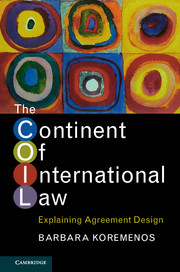Book contents
- Frontmatter
- Dedication
- Contents
- List of figures
- List of tables
- Acknowledgments
- 1 (Re)discovering the continent
- Part I COIL's building blocks: theory and data
- Part II Flexibility provisions in the design of international law
- Part III Centralization, scope, and control provisions in the design of international law
- 7 Dispute resolution provisions
- 8 Punishment provisions
- 9 Monitoring provisions
- 10 Asymmetric design rules, voting, and power
- 11 Conclusion
- Appendix 1 List of agreements in COIL sample
- Appendix 2 Coding rules
- Appendix 3 Selection issues in international cooperation data sets
- References
- Index
7 - Dispute resolution provisions
from Part III - Centralization, scope, and control provisions in the design of international law
Published online by Cambridge University Press: 05 June 2016
- Frontmatter
- Dedication
- Contents
- List of figures
- List of tables
- Acknowledgments
- 1 (Re)discovering the continent
- Part I COIL's building blocks: theory and data
- Part II Flexibility provisions in the design of international law
- Part III Centralization, scope, and control provisions in the design of international law
- 7 Dispute resolution provisions
- 8 Punishment provisions
- 9 Monitoring provisions
- 10 Asymmetric design rules, voting, and power
- 11 Conclusion
- Appendix 1 List of agreements in COIL sample
- Appendix 2 Coding rules
- Appendix 3 Selection issues in international cooperation data sets
- References
- Index
Summary
[T]he student of law and the student of politics … purport to be looking at the same world from the vantage point of important disciplines. It seems unfortunate, indeed destructive, that they should not, at the least, hear each other.
(Henkin 1979: 4)Only about one out of every two agreements in the COIL sample has any dispute resolution provision whatsoever. This empirical observation begs for an explanation, and which half needs explaining depends on where one is sitting. The standard IR realist perspective tells us that the dispute resolution provisions in those agreements that have them are simply cheap talk – just like the entire agreements. As Mearsheimer (1994: 7) argues, institutions “have minimal influence on state behavior.” A variant of this view is that international law does not change behavior because states enter into only those agreements that already align with their interests (Downs, Rocke, and Barsoom 1996). Consequently, it is irrelevant whether international agreements contain dispute resolution mechanisms. So the puzzle is why states bother putting such provisions in half of their agreements.
From many IL perspectives, the puzzle is why only half of the agreements have these provisions. Helfer and Slaughter (1997: 283), for instance, regard international tribunals as an integral part of “a global community of law.” Brunnée and Toope (2011: 308), coming from a constructivist perspective, emphasize not only that a perception of legitimacy and legality must exist, but that “the obligatory effect of international law must be generated and maintained through practices that sustain legality over time.” Based on the premise from the legalization literature that “courts and tribunals represent a key dimension of legalization” (Keohane, Moravcsik, and Slaughter 2000: 457), one could straightforwardly conclude that the existence and usage of dispute resolution mechanisms impart a more law-like character to international agreements, thereby enhancing their legitimacy and effectiveness. Thus, we would expect to see the inclusion of dispute resolution mechanisms in most, if not all, international agreements.
Indeed, Henkin's quote about the two very different vantage points of IR and IL is aptly illustrated by the disagreement over which half needs explaining: the half of the COIL sample that contains dispute resolution provisions or the half that does not.
- Type
- Chapter
- Information
- The Continent of International LawExplaining Agreement Design, pp. 199 - 225Publisher: Cambridge University PressPrint publication year: 2016



